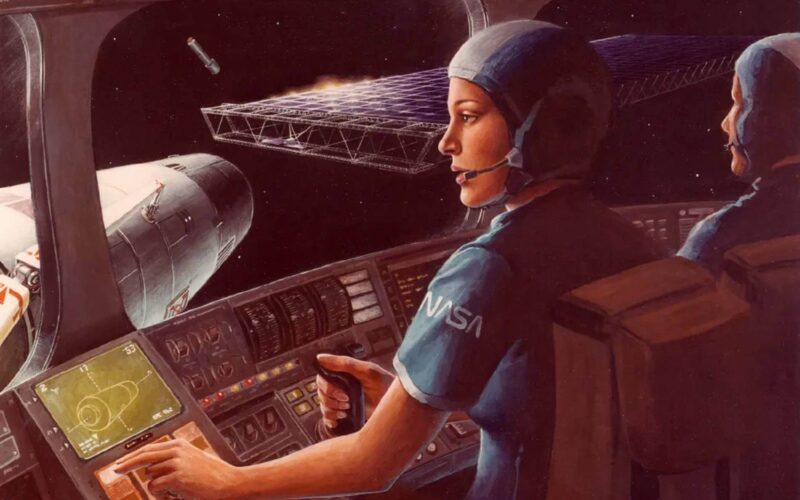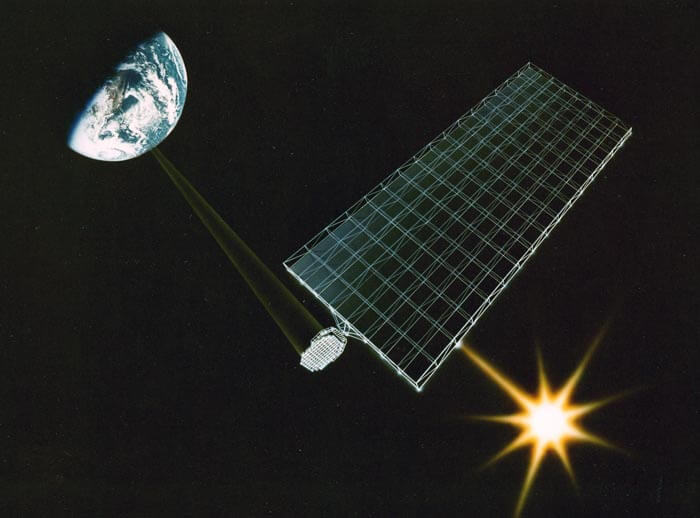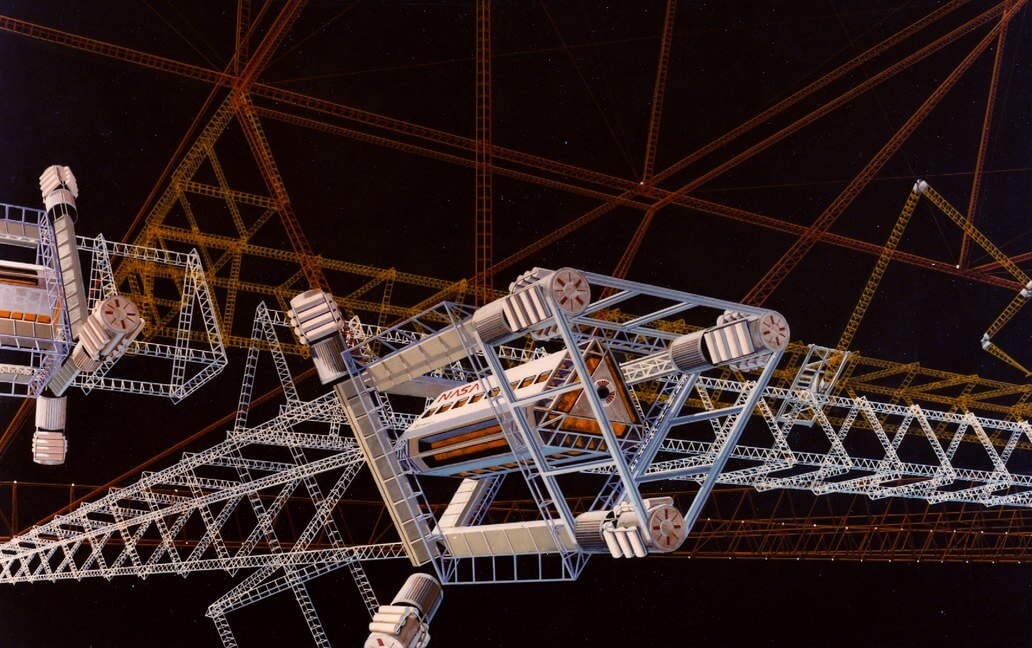During the Cold War there was no shortage of projects that could have come straight from the pages of a science fiction novel. But one stands out for being more ambitious than the others.
NASA’s Satellite Power System (SPS) was an idea to build an array of solar panels in space, and then beam the electricity down to Earth. Each of the panels was to be the size of a city, and they would be shipped to space by a fleet of the largest spacecraft ever built.
While this certainly sounds like something from a Hollywood movie, the proposal came just a decade after NASA’s moon landing, so futuristic projects seemed entirely within the realm of possibility.
An extensive multi-million-dollar evaluation program, run between the early 1970s and the early 1980s, found the idea of SPS to be both possible and viable. A rough timeline, drafted by scientists, envisioned that the first satellites adorned with solar panels would begin operation by the early 1990s.
But as the 1990s came around, the idea seemed to have been relegated to the realm of Sci-fi and one of the most ambitious projects of the 20th century had simply disappeared. But why?
It’s all about oil
It would have been almost impossible to pitch the idea of the SPS in the 1960s. For one, the Apollo Program, which succeeded in landing the first humans on the Moon, was in full swing at the time, and it was an unparalleled project in NASA’s portfolio. It was a monumental undertaking that required much of the agency’s resources.
Additionally, energy was cheap in the 1960s. Global oil prices barely reached $1.5 per barrel, a price that would seem absurd today.
But then, in 1973, the first oil crisis occurred, leading to fuel shortages and a five-fold increase in the price of oil. Rising electricity costs soon followed and ambitious projects to source cheaper energy became even more crucial. NASA set to work to find a viable solution to the energy crisis.
The idea of space-based solar panels first appeared in the 1940s, being popularly attributed to Isaac Asimov and his 1941 short story “Reason”. By the 1960s, early descriptions of how to implement the idea began to appear, most notably by Czech-born engineer Peter E. Glaser. NASA hired Glaser and his company to lead the first study concept, the results of which were published in 1974.
Glaser and his colleagues prepared a 190-page paper providing an optimistic outlook about the possibility of implementation of a solar panel as a means of capturing solar energy in space for transmission to Earth. While acknowledging that significant technological progress still needed to be made before the concept could be implemented, the study did not identify any overwhelming challenges or impossibilities. The study also outlined the ways progress could be achieved.
For the SPS to work, the price of space-generated electricity had to at least be on par with the price of energy generated by conventional means. To achieve this, a cost-effective method of getting the material into space, alongside some incredibly efficient solar panels, needed to be developed.
Space cities
Solar panels were the core of the whole idea. Placing them in orbit would make the solar panels far more efficient by removing a thick layer of atmosphere as well as the added complication of weather. Furthermore, there are certain orbits where objects don’t experience the day-night cycle, rotating around the Earth in a way that almost never puts them into the planet’s shadow. Space would provide a consistent power output.
Geostationary orbit (GEO) is perfect for that. The advantages mentioned above result in a solar panel that can collect 10 times the amount of energy than if it were installed on Earth. Additionally, objects in GEO stay at the same position in the sky in relation to objects on the surface of the Earth as they rotate around the planet at the same speed the planet rotates around its own axis. While substantially higher and harder to reach, such an orbit is perfect for direct, uninterrupted communication between a satellite and a spot on the surface of the Earth – up to and including a transfer of electricity through a microwave beam.
How would that be done? With the help of contraptions built to be the size of cities. By 1980, more than a dozen studies had been carried out to further elaborate on Glaser’s preliminary assessment. Most were conducted as a collaboration between NASA, the US Department of Energy (DoE) and various subcontractors. The prospective SPS began to take shape through those studies, revealing the full scope of the project.
It was envisioned that the project would consist of 60 satellites, each 10.5 kilometers (6.5 miles) long and 5.2 kilometers (3.2 miles) wide. Consisting of a metal frame covered with solar panels, the satellites were designed to be large black squares, which would be clearly visible in the sky as a string of unusually bright stars.
A steerable antenna would be attached at one end of each satellite. There, the gathered electricity would be converted to microwaves and beamed down to Earth. A concept drawing below shows such an arrangement. Note that the antenna alone, as it is depicted, is a kilometer (0.6 miles) wide.
A Space Power System satellite. (Image: NASA)
Constructing the trusses (Image: NASA)
The project envisaged that two satellites a year would be constructed between 1992 and 2022 by a workforce of 1000 astronauts. Semi-automated, the building process would see massive mobile factories assembling scaffolding-like structures by weaving aluminum into beams, beams into trusses and, finally, unrolling sheets of solar panels onto them.
The antenna would beam the energy to Earth, where a string of receiving antennas (rectennas) would convert microwaves back into electricity. These large flat structures would somewhat resemble the solar powerplants we are familiar with today, albeit at a much larger scale.
The plan to have kilometer-wide beams of intense microwave radiation dotted across the country was clearly a questionable proposition, and extensive environmental assessments have been conducted suggesting that many more studies will need to be undertaken before we can fully understand the effects of such a system on the environment. Additionally, further study would be required to find a way to safely implement the project.
Space trucks
Each SPS satellite has a mass of 50,000 tons, which is more than 100 times the current weight of the ISS, and the project proposed that 60 satellites would be constructed within a few decades. But how was all this material going to be transported into orbit?
The Space Shuttle, with its payload capacity of 29,000 kilograms (65,000 pounds), was inadequate for the job. Something much bigger had to be developed and, throughout the decade that the SPS was being envisioned, several solutions were put forward. Each solution was designed to be fully reusable as discarding a rocket after thousands of potential launches was unsustainable.
The Boeing Space Freighter was among these designs. It was a two-stage rocket with an upper stage reminiscent of the Space Shuttle, but far larger and capable of carrying 420 tons to LEO. NASA also attempted proposing its own Space Freighter of similar proportions, but more reminiscent of a Saturn V rocket from a decade ago. The Sea Dragon, a 150-meter (490 feet) tall rocket designed to be launched from underwater and designed to avoid the necessity of oversized launch pads was also proposed.
However, none of these proposals got as much attention, or were as undeniably impressive, as the Star-Raker.
Designed by North American Rockwell, it was a gargantuan single-stage-to-orbit spaceplane capable of carrying more than 53 tons of payload to LEO. With the loaded weight of 2,130 tons (four times that of the Antonov An-225) and a wingspan of 93 meters (just short of that of the Hughes H-4 Hercules) it would have become the largest and heaviest aircraft in operation.
Complete with an array of turbofan, ramjet and rocket engines for use during various stages of the flight, the Star-Raker would be able to take-off at almost any commercial airport, fly to the equator, accelerate to hypersonic speed and blast into orbit, before delivering materials to LEO.
A short animated clip below shows a part of such an operation, with the Star-Raker flying directly to GEO, a feat it was not designed to do, and one that would require it to exchange a significant part of its payload for additional fuel.
At LEO the space plane, or any of other space trucks proposed for the program, would transfer materials to a special station. Another spacecraft, designed specifically for operations in space, would then take the materials further into GEO.
It’s all about oil…again
Transporting material to LEO alone is incredibly expensive. The cost of getting there on the Space Shuttle was more than $52,000 per kilogram (over $25,000 per pound). Preliminary studies for the SPS assumed that this cost could be brought down to $220/kg ($100/lb) and reduced even further as the mass economy kicked in, with the help of the Star-Raker or any of the alternative systems.
With that, the cost of generating electricity on the SPS would be around $1,380 per kilowatt for the prototype, and $250 per kilowatt when the stations began to operate at full capacity.
While the first was not impressive by 1970s standards, as only the second figure was competitive, by the 1990s, in part thanks to inflation, the cost of generating electricity at nuclear powerplants rose to $1,900 per kilowatt, before doubling again by 2009.
Would that make the SPS a viable alternative by today’s standards? Nobody actually knows.
On one hand, the technological gains envisioned by the scientists behind the SPS project do not seem that far-fetched. Glaser’s initial study assumed that the solar panels on the satellite would generate 26.7 milliwatts per square centimeter, an efficiency that was pure science fiction back then.
As of 2022, commercially available top-of-the-line solar panels have a nominal output of more than 20 milliwatts per square centimeter when used on Earth, and without the significant boost granted by the removal of atmospheric interference.
Glaser also imagined his solar panels costing $0.0062 per square centimeter. The same solar panels used in the example above cost approximately four times this amount, although it is difficult to imagine how much the cost could be driven down had they been produced at the quantities needed for the SPS, or if such a scalability is even possible.
Finally, the current record-holder for the cheapest payload-to-space transfer, the Falcon Heavy rocket, would cost approximately $1,600 per kilogram ($727 per pound) to reach LEO. Only the SpaceX Starship, which is not yet operational at the time of writing this article, promises to bring those costs below the $200-per-kilogram line envisioned by the scientists behind the SPS.
Are we there yet?
It’s 2022, the year Glaser envisioned the SPS becoming fully operational, and the SPS has yet to be realized. Would this have still been the case if billions of dollars had been invested into the program? We’ll never know.
In 1980 Ronald Reagan was elected US president, and the country’s space policy shifted. While studies on the SPS were still being published, NASA began to shrink the budget allocated to the project.
The cost of oil stabilized as the new administration moved on with a controversial decision to deregulate the market. An array of clean energy-driven initiatives were defunded, reversing much of the previous progress in this area.
NASA’s budget, vastly reduced from its 1960s peak, continues to be reduced even further, a trend that has largely continued to this day. With defense initiatives being favored over space exploration (a period some NASA employees have described as the ‘dark ages’), there was no place left for monumental programs on the scale of the SPS, let alone ones that could rival the Apollo.
Technically the project was not dropped, rather the studies were not followed up by development programs.
NASA revisited the idea again in 1997, publishing some new studies and proposing several more modest concepts when compared to those that had come before. Some of this work led to small-scale experiments exploring the use of solar power in space. While successful, they never resulted in a single milliwatt being beamed down to Earth.
And so, the SPS went from being an impressive program aiming to build city-sized satellites, to eventually becoming a part of small-scale experiments and concepts, a mere fraction of the grand plans that were within sight back in the 1970s.



